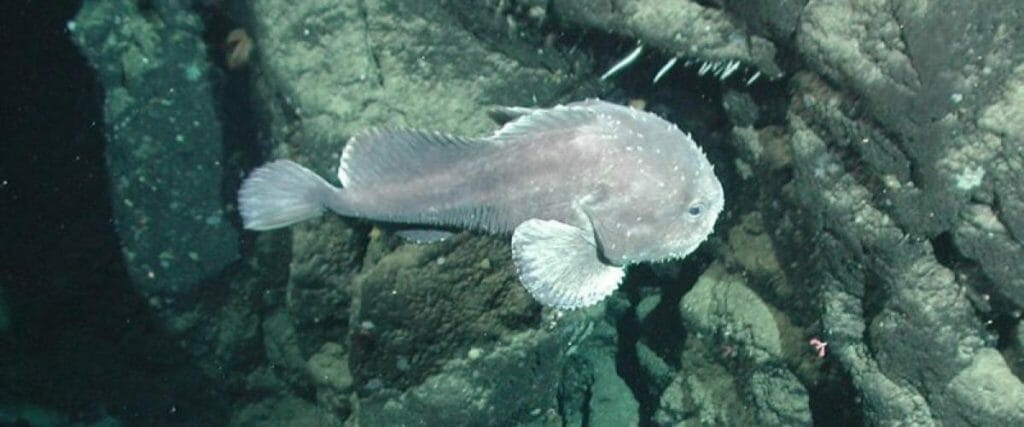Blobfish: "The World's Ugliest Creature" is not as ugly as you think!

Blobfish live in the deep waters off the coasts of Australia and New Zealand. The blobfish may be considered ugly, but imagine living at the pressure at the bottom of the sea! The blobfish can live at depths 2,500 feet below, where they float slightly above the floor of the ocean, and wait for small crustaceans and other edible matter to pass by so it can suck them up for food. The fish, which shrivels up when exposed to air, is inedible, but has still been facing risks and has become endangered as they are often caught as bycatch accidentally. Most blobfish encountered by humans are dead ones found by deep-sea fishers that use nets to sweep up marine animals from the bottom of the ocean in an effort to catch edible fish. As you can see in the picture below, they look very different while in their natural habitat versus when they are damaged by fishers.

It is hard to estimate how many blobfish are left since they live so deep underwater, but one popular estimate indicates that only about 420 blobfish exist worldwide. This means they are extremely endangered and at great risk of extinction. Blobfish live in the deep waters off the coasts of Australia and New Zealand.
The blobfish plays an important role in the ecosystem. They serve as bottom feeders: keeping the population of crustaceans and mollusks down, as well as feeding on plants matter which keeps the ocean floor clean. If blobfish go extinct, there will be an overpopulation of mollusks, and this would cause problems in the food chain to lose the bottom feeder.
The cause of the decline in the number of blobfish is a combination of factors. As mentioned earlier fishing and blobfish being caught as bycatch is a major issue and is completely pointless and damaging for humans to do since blobfish aren't even edible. Pollution is also hurting blobfish, microplastics and litter in the sea can sink to the bottom of the ocean, so the blobfish mistakenly eat it since it's their only food source.
We should care about protecting this unique and special sea-creature because without it the food chain of these underwater creatures would be damaged. The extinction of blobfish means that there would be a hole in the food web, meaning overpopulation of the small mollusks they consume, killing everything under them in the food web.
Current conservation efforts for blobfish is difficult because they live so far beneath the surface and cannot be brought up without damaging their bodies, so conservation-focused breeding is not possible. The best conservation efforts are to reduce pollution and protect their habitats from damage and fishing.
Geospatial tools and geography aids can help the conservation of blobfish through locating where blobfish are and avoid the use of deep-sea fishing there.
There are some ways you can help the blobfish, as well as other sea creatures.
1. Properly dispose of plastics, and avoid generating ocean microplastics when you can. Make sure you try to recycle plastics as much as possible, and that you never litter.
2. Reduce plastic use as much as possible. Do not purchase items that are single-use plastic, and try to reuse any plastic containers you already have and in the future instead opt for refillable or plastic-free alternatives in the future. Easy swaps include reuseable straws, travel-sized cutlery sets, and switching to a safety razor with refillable blades (which I actually enjoy using much more than my old plastic disposable ones!) Use up your current plastics as much as possible before purchasing new ones though!
3. Participate in ocean and water cleanups when you can and if you are in an area where you can do so. This is a great volunteer activity and helps you support your community as well as the ecosystem.
4. Lower your consumption of seafood. Buying frozen seafood instead of highly perishable fresh fish can also help reduce waste. We can also avoid purchasing any seafood that is caught using methods that harm the blobfish population, like trawling. To find out if your seafood is caught in methods that involve bycatch, look for certifications like the MSC blue fish tick. This label shows that the seafood can be traced back to healthy fish populations that have been sustainably fished.
5. Avoid supporting bycatch methods by avoiding fish with high rates of bycatch. According to the 2014 Oceana Report, several different species and groups of fish have bycatch rates of over 60%. These include snapper, grouper, halibut, shrimp (brown, pink, and white), swordfish, and thresher sharks. The worst offenders are those caught with trawling nets. Opt for species and types of fish that have low rates of bycatch, like sardines.
Protect the blobfish!





Comments
Post a Comment